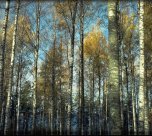
Valuable broadleaved tree species, such as European ash (Fraxinus excelsior), sycamore maple (Acer pseudoplatanus), wild cherry (Prunus avium), walnut (Juglans regia, J.nigra and hybrids), wild service tree (Sorbus torminalis), black alder (Alnus glutinosa), lime (Tilia cordata) and birch (Betula pendula, B. pubescens) are an increasingly important element of forest production in Europe. The natural range of these valuable broadleaved species expands from Finland in the north, to Italy in the south, from Poland in the east to France in the west. Regionally, they often occur in a mixture with other broadleaved trees and conifers. (to see the final list of E42 target tree species please click here)
These tree species have been neglected over time and pushed back from their natural sites by forest devastation in former times and afforestation with coniferous species such as Norway spruce and Scots pine. In addition, the shortage of wood in European forests favoured fast growing species and less demanding species and has affected the composition of tree species substantially. Little or no knowledge on the management of valuable broadleaved tree species reduced the willingness to cultivate these species, leading to a low supply of valuable timber. This development has contributed to the expansion of European monoculture forests with little diversity of habitats. Ecological and economic considerations recently increased the interest in growing valuable broadleaved tree species. High-quality timber of these tree species consistently realise high prices on the market and demand exceeds supply. The wood of lower quality, of which there is more supply than demand on the market, is of far less value. Even so the demand for valuable timber has increased recently, and there is a notable interest among forest owners and farmers to grow valuable broadleaved species, the current level of knowledge of these species is insufficient. More information on how to grow valuable broadleaved species to obtain high-quality wood and more research on new opportunities for forest management will be needed.
Valuable broadleaved tree species are generally light demanding and grow in forests with varying canopy closure. As competition induced natural pruning can possibly be replaced by artificial pruning of open grown trees, alternative management options offer innovative ways for the production of valuable wood. These management options may at the same time also increase the supply of non-wood products and services. Such forests can be grown successfully as part of an existing forest management regime, after afforestation of farmland, in orchards, along roads, in private and public forests and in a mixture with both broadleaved and coniferous trees in stands of varying density. With the right treatment they can yield high quality timber within relatively short production times. They increase the attractiveness of the forests and the landscape through their diversity, their special characteristics and aesthetic features. Valuable broadleaved forests may form important habitats for numerous plants, insects, fungi and animals, some of them endangered.
As urban forests are becoming increasingly important for people living in cities and land traditionally managed for forestry is under pressure to change, new ways of managing forests need to be explored. Non-wood products, some of them traditional such as apiculture, could be a parallel source of livelihood in combination with growing valuable broadleaved tree species. Using the ideas of agroforestry in combination with the management of valuable broadleaved trees may create new and innovative management regimes. New ways of multiple land uses may arise as better habitats offer opportunities for raising livestock. These may also generate jobs and new business ideas, ultimately offering people in rural regions a possibility to make a living other than from pure farming and forestry. At the same time rare habitats and endangered species are being preserved and the diversity of nature maintained.
Multiple use forests close to settlements put new demands on modern forestry. Landscape values form an important part for the planners and designers of these urban recreational areas. How can forestry practices be integrated on tree level, stand level and regional level in the landscape without endangering the uniqueness and beauty of the area in question? It is a growing need for new innovative ideas on how to work with valuable broadleaved trees in the different dimensions of the forest, taking into consideration the aesthetic, ecological and economic values of the landscape and environment, while working together with stakeholders such as small forest owners, farmers and the wood industry, to find adequate solutions.
The main objective of the Action is to increase the knowledge of growing valuable broadleaved tree species, with emphasis on the production of valuable timber and with the intent to promote non-wood products that can be produced in parallel with, or in addition to, the main product. Examples of broadleaved tree species include sycamore maple, wild cherry and European ash, as well as walnut (Juglans regia, J.nigra and hybrids), wild service tree (Sorbus torminalis), black alder (Alnus glutinosa), lime (Tilia cordata) and birch (Betula pendula, B. pubescens). In respect to wood production the goal is to maximise the share of highly valuable timber in a short production time and low investment of labour, energy and capital. At the same time, new ways of growing valuable broadleaved trees will be investigated, i.e. new ideas on where and how to grow these species will be developed, while taking the aims and restrictions of the production of non-wood products into consideration. Such products are biodiversity, nature conservation, habitat values, landscape and recreational values, and products that can be collected or gathered as by-products parallel to the main product timber. Non-wood products and values will be regarded as an important part of the research, and are to be integrated with the wood production and management objectives of this Action. These goals will be achieved through the cooperation of many different European countries, represented by universities, research centres, forest owners and other stakeholders. A broader perspective and new ideas on how to achieve the goals of this Action will emerge. Specific goals are: